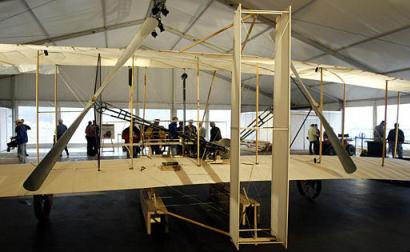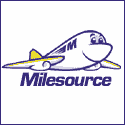
Mon Dec 15, 3:26 PM ET
Wrights Saw Plane As Instrument of Peace
By WILLIAM L. HOLMES, Associated Press Writer
 KILL DEVIL HILLS, N.C. - The Wright brothers envisioned early on that their flying machine would have a place in the machinery in the war. Their hope was that it would result in peace.
A century later, military aviation has a mixed legacy, giving nations the ability to level cities from miles away while protecting troops from deadly close combat.
"It's an integral part of how we operate," said Navy Cmdr. Rich Dann, a military historian.
Orville and Wilbur Wright suspected their invention could be. The first potential buyer they contacted immediately after their first flights on Dec. 17, 1903, was the U.S. government, their great grandniece Amanda Wright Lane said Monday. The government turned down the Wrights three times before signing them to a $25,000 contract in 1908.
"They felt very strongly that our government be the first to have the airplane," Lane said.
The contract called for a two-seat plane that could travel 125 miles at up to 40 mph and land without crashing.
The Wrights initially believed the airplane could be used to spy on opposing forces, she said. Later, they suggested using it to bomb heads of state or the buildings where policy-makers worked.
"They weren't mad at the guys in the trenches," said Stephen Wright, Lane's brother. "They were mad at the guys in the government."
But by World War I, planes already battled in the air as they conducted reconnaissance missions, Dann said. Planes could launch from the deck of aircraft carriers by the second World War and travel faster and longer, allowing bombing of troops and cities. A nuclear bomb delivered by an airplane leveled Hiroshima, Japan, and brought the war to a close in 1945.
Most recently, U.S. planes sliced the sky over Baghdad, Iraq , delivering targeted missile strikes that chipped apart the city and its infrastructure. The technology undoubtedly saved U.S. troops from having to storm the city when power, water and other resources would have been available to their enemies.
Lt. Col. Kevin Gross, the chief test pilot for the experimental V-22 Osprey, said the aircraft he's piloting could further change the way wars are fought. The development of the Osprey has been delayed by two crashes in 2000, one in Arizona that killed 19 and another in eastern North Carolina that killed four people.
The Osprey can take off and land like a helicopter and fly like an airplane, allowing it to quickly deliver up to 24 Marines to tight spots up to 800 miles away without refueling, said Gross, who was at Wright Brothers National Memorial on Monday for a demonstration of the Osprey's capabilities. The demonstration was part of the celebration of the centennial of powered flight.
Battles such as those on D-Day in World War II, where thousands of troops stormed beaches from amphibious assault vehicles and were often killed within seconds, are no longer necessary, he said.
"Tremendous effort and loss of lives occurred in those conflicts," Gross said. "With the speed and flexibility of the V-22 we can deliver our Marines faster."
The technology of such a plane surely would have impressed his great uncles, Stephen Wright said. The notion that war continues would have disappointed them, he said.
"I think they would think we haven't made too many advances," Wright said.
In 1937, as the power of the airplane as a tool of war became increasingly evident, Orville Wright was asked if he and his brother would have worked to uncover the secrets of flight if they had known of its destructive power.
"I thought the airplane would bring peace," he said in an interview published in The Washington Herald. "I thought it would bring war home to the people of every nation. I thought that an airplane could fly over an enemy capital, and that no nation would dare go to war with such a weapon in existence. ...
"It was to us an interesting experiment, purely a matter of science. And we didn't know the world would go crazy."
The Associated Press contributed to this report.
Copyright © 2003 The Associated Press. All rights reserved. The information contained in the AP News report may not be published, broadcast, rewritten or redistributed without the prior written authority of The Associated Press.
AviationHistory.org shall not be liable for any errors or delays in the content, or for any actions taken in reliance thereon.
|













